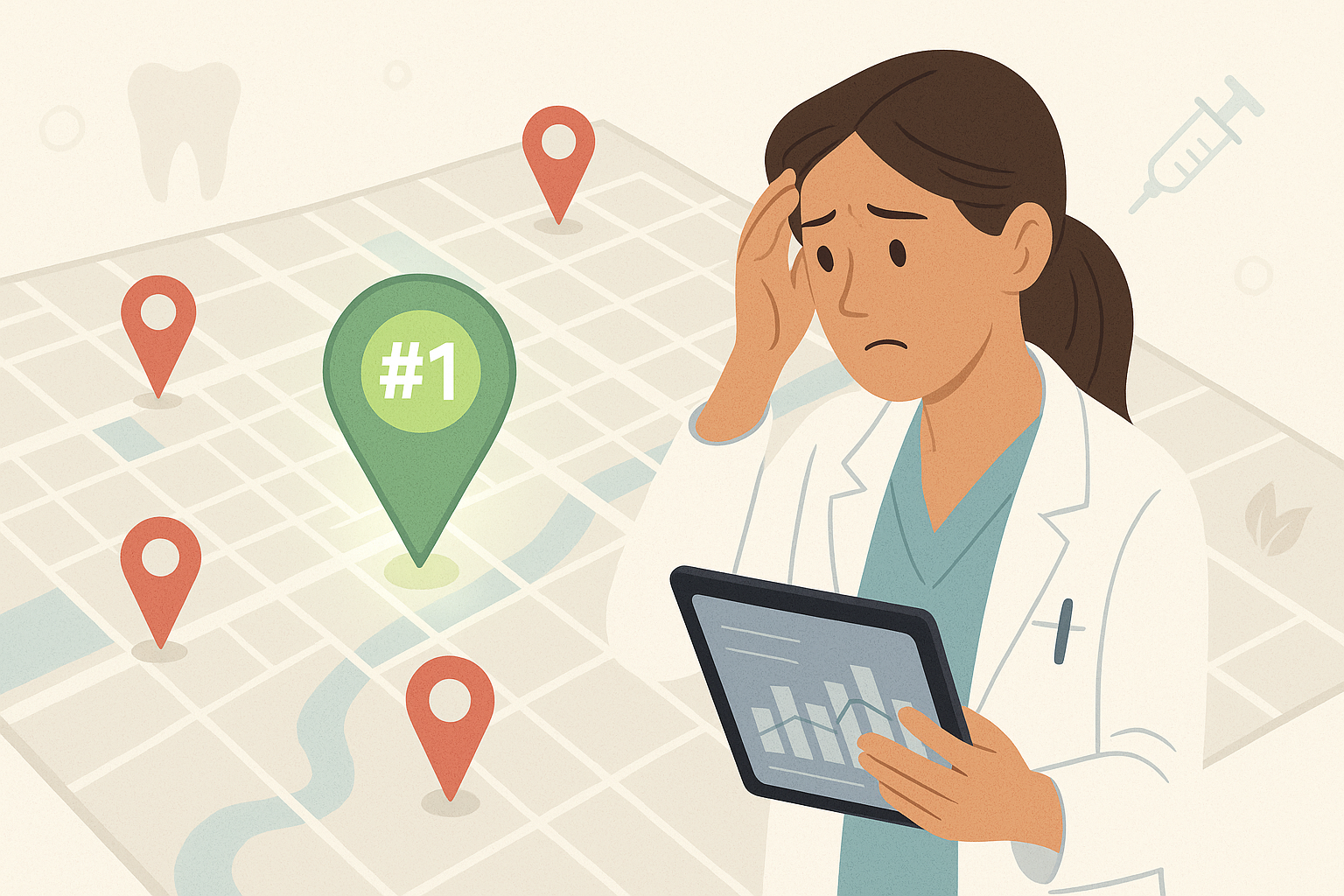How to Train Your Team on Map Rank Tracking & Reporting in One Afternoon
If you don’t know where your practice stands on Google Maps, you are missing out on patients—and your competitors are gladly welcoming them in.
Let’s be honest. Your front desk doesn’t have time to learn SEO, and your agency? They might send a monthly report, but no one reads it. Meanwhile, when people search for “best [your service] near me,” someone else is getting that click.
That ends today. In just one afternoon, you can train your team to track and report on your Google Map rankings. No fluff, no overcomplicated tech—just a streamlined, smart approach that ties visibility directly to booked appointments.
Your Map Ranking Is the Digital Equivalent of Your Curb Appeal
Think about it. If a patient walked into a clinic with cracked floors and a dusty front desk, they might walk right out. The same thing happens online. If your practice doesn’t show up in the top three Google Map results, you are virtually invisible.
Google Maps results are where most high-intent patients make their decisions. These spots are powered by your Google Business Profile, not your website or ads, which means that even with great content or paid search, if you are missing from the Map Pack, patients may never see you.
In this guide, you’ll learn how to:
- Get your team aligned on why local rankings matter
- Choose the right tracking tool for your practice
- Train one person to own reporting without adding more to your plate
- Use reports to improve rankings and track ROI
Let’s dive in.
1. Start With a Simple Question That Gets Everyone’s Attention
Before you bring in tools or training, ask your team this question:
“When someone searches for our service nearby, where do we show up?”
You’ll often get blank stares or confused shrugs. Most staff members have no idea how Google Maps works, let alone that it is separate from traditional search results.
Start by explaining that local visibility drives patient trust and appointments. According to Google, 78% of local mobile searches result in an offline visit or purchase within 24 hours. This makes it one of the most powerful levers you can pull to grow your practice.
Quick Tip: Open an incognito browser window and have your team search terms like “medspa near me” or “pediatric dentist [your city].” If they can’t find your practice in the top three results, they’ll instantly understand the issue.
Quote:
“If you’re not showing up on maps, you don’t exist to the patient.”
— Joy Hawkins, Google Maps SEO Expert
2. Use the Right Tools to Track Rankings Without Guesswork
You do not need to track this manually or mess with spreadsheets. Local rank tracking tools like Local Falcon, BrightLocal, or GeoGrid make everything visual and automated.
These tools show where you rank across your service area by GPS coordinates, ZIP codes, or neighborhoods. You can see where you are winning and where you’re invisible. Even better, you can break it down by service keywords such as “coolsculpting,” “urgent care,” or “emergency dentist.”
Quick Tip: Start with one tool. Set up reports for your top five services and key locations. Train your team to check these once per week.
Stat: Practices that track local rankings consistently improve map visibility by 34% in under three months (BrightLocal, 2023).
Quote:
“Data removes doubt. Show your team the numbers, and they’ll get why it matters.”
— Darren Shaw, Founder of Whitespark
3. Assign a Visibility Champion Instead of Relying on Marketing
Your internal team is already busy. But you don’t need a full marketing department to win locally. All you need is one responsible person who can own this simple weekly habit.
It could be your office manager, lead assistant, or patient coordinator. What matters is that they understand the process and take five minutes weekly to check rankings, monitor reviews, and report changes.
This person should:
- Log into your tracking tool weekly
- Track Google reviews and NAP (Name, Address, Phone) consistency
- Flag ranking changes or issues
- Report key trends monthly
Quick Tip: Add a five-minute “visibility check-in” to your weekly team huddle. This keeps your Map rankings visible and actionable.
Quote:
“Small consistent actions beat one big marketing push every time.”
— Marcus Sheridan, Author of They Ask, You Answer
4. Keep Reporting Simple and Focused on What Matters
Most practice owners get overwhelmed by bloated SEO reports. You don’t need 40 data points. Just track the five that actually impact patients walking through your door.
Track:
- Your average ranking for each core service
- How many reviews you have
- How many new reviews you get each month
- Where you rank in the top 3 compared to the top 10
- Your Google Maps click-through rate
Keep it in a simple spreadsheet or dashboard that anyone can understand at a glance.
Quick Tip: Use conditional formatting (like red-yellow-green colors) to highlight ranking progress. It makes changes easier to see.
Stat: Practices that simplify their local SEO reports are twice as likely to act on the data (Moz Local SEO Industry Report, 2024).
Quote:
“What gets measured gets improved—but only if it’s understood.”
— Peter Drucker
5. Connect Rankings to Real Appointments to Show Value
Your team might not care about rankings unless they see how they impact booked appointments. That is why it’s crucial to connect visibility to actual results.
You can use tools like CallRail or WhatConverts to track calls, form submissions, or chats that come from your Google Business Profile. Once you start saying things like “Ranking in the top 3 led to 22 new patient inquiries this month,” you have buy-in.
Quick Tip: Set a visibility goal with your team. For example, “Let’s reach the top 3 for ‘dermatologist near me’ in three key neighborhoods by the end of the quarter.”
Stat: Businesses in the top 3 Google Map results get 60 to 70% of local clicks (Search Engine Journal, 2023).
Quote:
“Make the outcome real. When the team sees patients from rankings, they care.”
— Neil Patel, Digital Marketing Expert
6. Share Progress Visually With a Simple Monthly Dashboard
Once your visibility champion is tracking data, don’t let it live in a silo. Share the highlights with the full team so everyone stays motivated.
This could be a slide in your monthly meeting, a printed dashboard at the front desk, or even a Slack message that says, “We’re now ranking #2 for ’emergency dental care’ in downtown!”
Celebrate wins like:
- Entering the top 3 for a new service
- Reaching 100 five-star reviews
- Holding a top spot for 60+ days
Quick Tip: Reward the team when rankings improve and appointments follow. Gift cards, lunch treats, or simple shout-outs build momentum.
Quote:
“What you recognize gets repeated. Turn visibility into a team sport.”
— Verne Harnish, Founder of EO
Summary: You Can Build a Local Visibility System in One Afternoon
Let’s recap your afternoon training plan:
- Ask your team where you show up on Google Maps
- Explain why rankings matter for patient acquisition
- Pick a rank tracking tool and set up five key service areas
- Assign one visibility champion to review weekly
- Focus on five simple metrics that drive results
- Connect rankings to patient inquiries using tracking tools
- Share progress and celebrate wins regularly
This is not another marketing task that drains your time. It’s a low-lift, high-impact system that builds trust, drives bookings, and increases your valuation.


